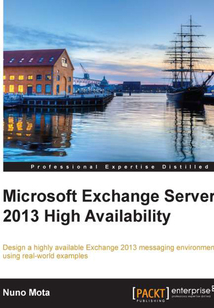舉報 

會員
Microsoft Exchange Server 2013 High Availability
最新章節:
Index
Thisbookisahandsonpracticalguidethatprovidesthereaderwithanumberofclearscenariosandexamples,makingiteasiertounderstandandapplythenewconcepts.Eachchaptercanbeusedasareference,oritcanbereadfrombeginningtoend,allowingconsultants/administratorstobuildasolidandhighlyavailableExchange2013environment.IfyouareamessagingprofessionalwhowantstolearntodesignahighlyavailableExchange2013environment,thisbookisforyou.Althoughnotadefiniterequirement,practicalexperiencewithExchange2010isexpected,withoutbeingasubjectmatterexpert.
目錄(65章)
倒序
- coverpage
- Microsoft Exchange Server 2013 High Availability
- Credits
- About the Author
- About the Reviewers
- www.PacktPub.com
- Support files eBooks discount offers and more
- Preface
- What this book covers
- What you need for this book
- Who this book is for
- Conventions
- Reader feedback
- Customer support
- Chapter 1. Getting Started
- Defining high availability and resilience
- Introducing the new Exchange architecture
- Summary
- Chapter 2. High Availability with the Client Access Server
- Removing session affinity
- Connecting to Outlook
- Load balancing and CAS arrays
- The Autodiscover service
- Summary
- Chapter 3. High Availability with the Mailbox Server
- Reducing input/output operations per second
- Automatically recovering after storage failures
- Managed Store
- Automatic Reseed
- Revisiting Database Availability Groups
- Introducing modern Public Folders
- Explaining the Offline Address Book
- Summary
- Chapter 4. Achieving Site Resilience
- Achieving site resilience for client access server
- Achieving site resilience for the Mailbox server
- Summary
- Chapter 5. Transport High Availability
- Servicing of the transport pipeline
- Improving on transport high availability
- Making an inbound and outbound e-mail flow resilient
- Summary
- Chapter 6. High Availability of Unified Messaging
- Introducing the new features of UM
- Architectural changes
- Unified Messaging ports
- Unified Messaging availability
- Summary
- Chapter 7. Backup and Recovery
- Understanding the importance of backups
- Planning for disaster recovery
- Dial tone portability
- Summary
- Chapter 8. Monitoring Exchange
- Introducing Managed Availability
- Using the Exchange 2013 SCOM Management Pack
- Summary
- Chapter 9. Underlying Infrastructure
- Active Directory
- Domain name system
- Explaining the importance of a network
- Using high available storage
- Benefiting through virtualization
- Summary
- Index 更新時間:2021-07-19 18:25:55
推薦閱讀
- 審計全流程技術操作實務指南
- 資本的眼睛
- Citrix XenApp? 7.5 Desktop Virtualization Solutions
- 審計學
- Citrix? XenMobile? Mobile Device Management
- 陜西文物年鑒·2015
- 大數據搜索與挖掘及可視化管理方案 :Elastic Stack 5:Elasticsearch、Logstash、Kibana、X-Pack、Beats (第3版)
- 基本有用的計量經濟學
- 審計基礎
- 從零開始學房地產會計
- 風險導向審計準則實施效果研究
- 企業內部審計全流程指南
- 內審人員進階之道:內部審計操作實務與案例解析
- 計量經濟學理論與應用:基于Eviews的應用分析
- 內部審計情景案例:理解審計行為,辨析審計決策
- Oracle E-Business Suite Financials R12:A Functionality Guide
- 統計學理論前沿(谷臻小簡·AI導讀版)
- Managing Virtual Infrastructure with Veeam? ONE?
- 規范內部審計的28個技巧
- Instant Windows PowerShell Guide
- 獨立審計質量的激勵治理模式研究
- PMP 5A備考寶典
- TIBCO Spotfire for Developers
- Oracle Enterprise Manager Cloud Control 12c:Managing Data Center Chaos
- Mastering Parallel Programming with R
- 內部審計工作指南:穿透實務核心,進階數智應用,精益審計管理
- Microsoft Dynamics GP 2013 Financial Management
- Creating Universes with SAP BusinessObjects
- Learning Qlikview Data Visualization
- 舞弊導向審計模式研究:基于風險控制角度

